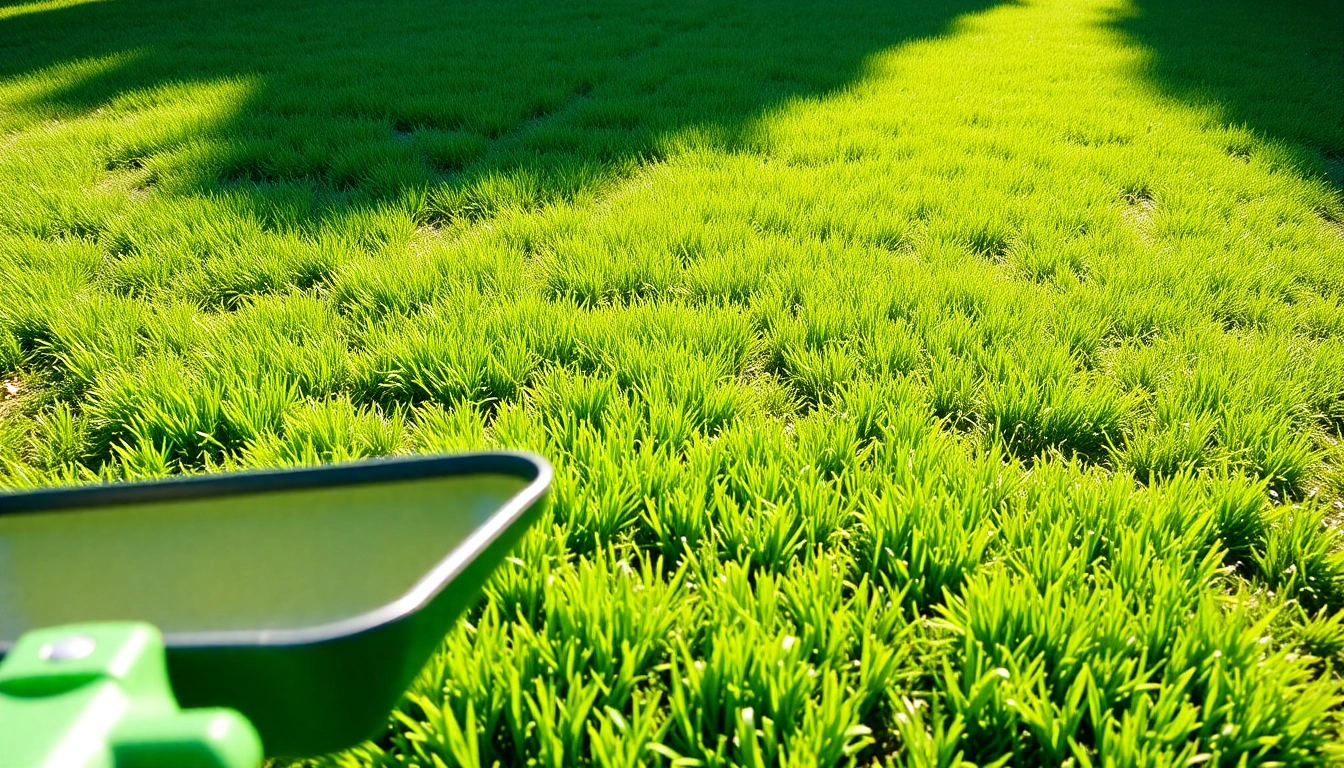Understanding the Basics of Over Seeding
What is Over Seeding?
Over seeding is a lawn care practice that involves planting grass seed directly into existing turf without tilling the soil or tearing up the current grass. This method is primarily used to rejuvenate lawns that have become thin or patchy over time, allowing for a lusher, greener appearance. By introducing new seeds to an established lawn, you not only fill in bare spots but also enhance the overall health and density of your lawn.
Benefits of Over Seeding Your Lawn
The benefits of over seeding are plentiful and can significantly enhance the quality of your lawn. Some key advantages include:
- Improved Lawn Density: By adding new grass seeds, over seeding helps thicken your lawn, reducing the spaces where weeds can take root.
- Revitalized Grass: Introducing newer varieties can increase the lawn’s resistance to disease, insects, and environmental stressors.
- Enhanced Visual Appeal: The application of fresh seed leads to a more uniform color and texture in the grass, making your lawn look vibrant and well-maintained.
- Increased Soil Health: As new grasses grow, they contribute to soil health by preventing erosion, improving water retention, and promoting biodiversity.
- Cost-Effective Lawn Care: Over seeding is generally less expensive than complete lawn renovation, providing a budget-friendly solution for maintaining a healthy lawn.
Ideal Timeframes for Over Seeding
Timing is crucial for successful over seeding. The best times generally fall in late summer to early fall, when soil temperatures are warm enough for seed germination, yet the cooler air temperature encourages growth. Spring is also a suitable timeframe, but it may require more frequent watering due to higher temperatures affecting moisture levels. Monitor weather patterns and adjust your timing accordingly to ensure optimal conditions for seed germination.
How to Successfully Over Seed
Preparation Steps Before Over Seeding
Before you start over seeding, proper preparation is key to achieving success:
- Mow the Lawn: Cut your existing grass shorter than usual to expose the soil. This allows the seeds to reach the soil and take root more easily.
- Rake the Lawn: Use a rake to remove debris such as grass clippings, leaves, and dead grass to create an optimal surface for seed placement. This also helps loosen the top layer of soil, encouraging better seed contact.
- Test Soil Quality: Conduct a soil test to check nutrient levels and pH. This information can guide you in choosing the right fertilizers and amendments to apply after seeding.
Choosing the Right Grass Seed
Selecting the appropriate grass seed for your lawn is crucial to successful over seeding. Factors to consider include:
- Climate: Identify whether your region is conducive to cool-season or warm-season grasses. Cool-season grasses thrive in areas with cold winters, while warm-season grasses flourish in warmer climates.
- Sunlight Exposure: Consider the amount of sunlight your lawn receives daily. Some grasses perform better in full sun, while others can adapt to shaded areas.
- Lawn Use: Assess how you use your lawn. High-traffic areas may require more durable grass varieties to withstand wear.
Techniques for Effective Seed Distribution
There are several methods to ensure even and effective distribution of grass seed:
- Broadcast Method: Use a hand-held broadcast spreader for larger areas to distribute seeds evenly across the lawn.
- Drop Seeder: A drop seeder can also be effective, especially for smaller areas where precision is necessary.
- Hand Broadcasting: For smaller patches, you can hand scatter the seeds, ensuring to cover them well while maintaining the right seed density.
Over Seeding Tips for Different Lawn Types
Over Seeding Cool-Season Grasses
Cool-season grasses, such as Kentucky bluegrass and fescue, are typically over seeded in early fall or late spring. These grasses thrive in regions where temperatures are cooler, and they require consistent watering during dry spells to help germinate properly. When over seeding these grasses:
- Use high-quality seeds with good germination rates.
- Consider mixing older varieties with newer, disease-resistant ones for enhanced resilience.
- Fertilize with a starter fertilizer to boost growth during the early stages.
Over Seeding Warm-Season Grasses
Warm-season grasses like Bermuda and zoysia should be over seeded later in the spring as they require warmer soil temperatures to germinate. When working with these grasses:
- Ensure soil temperatures are at least 65°F for optimal germination.
- Monitor irrigation closely, as warm-season grasses typically need more water during the germination phase.
- Thin out existing grass before applying seed to improve seed-to-soil contact.
Common Challenges When Over Seeding
Over seeding can be challenging due to various factors such as:
- Competition from Existing Grass: In some cases, older grass may outcompete the new seedlings. Adequate preparation and timely watering can mitigate this.
- Pest and Disease Issues: New seedlings may be susceptible to pests or diseases. Regular monitoring and maintaining healthy lawn care practices can address potential issues.
- Environmental Factors: Extreme weather, whether too hot or too wet, can hinder seed germination. Adjust your watering and care strategies based on current weather conditions.
Post-Over Seeding Care
Watering and Fertilization Strategies
Post-over seeding care is critical to help new seedlings thrive:
- Watering: Water the newly seeded areas lightly and frequently, ideally two to three times a day, to keep the soil consistently moist without causing runoff.
- Fertilization: Apply a starter fertilizer rich in phosphorus to encourage root growth. Follow manufacturer instructions for timing and quantity.
Signs of Successful Over Seeding
Recognizing the signs of successful over seeding will help you understand what’s working. Look for:
- New sprouts emerging within 7-14 days.
- Greener, thicker patches of grass replacing bare spots.
- Uniformity in grass height and density across the lawn.
Maintaining Your Lawn Post-Over Seeding
Once your new grass is established, it’s essential to maintain it properly to ensure longevity:
- Continue to water regularly, but gradually reduce frequency as the grass matures.
- Mow the grass to a healthy height, avoiding cutting more than one-third of its height in a single mow.
- Apply regular fertilization based on the type and needs of your grass to promote ongoing health.
Resources and Expert Guidance on Over Seeding
Tools and Equipment for Effective Over Seeding
Various tools can facilitate the over seeding process:
- Broadcast or Drop Seeders: Ideal for large areas.
- Rakes and Aerators: Essential for preparing the soil and enhancing seed-to-soil contact.
- Watering Equipment: A sprinkler or irrigation system ensures consistent moisture during the germination phase.
Professional Services for Lawn Care
If you feel overwhelmed or want to ensure optimal results, consider hiring professional lawn care services. Experts can provide:
- Consultation on the best practices suited for your specific lawn type.
- Assistance with preparation and overseeding techniques that fit your lawn condition.
- Ongoing care and maintenance strategies to maximize your lawn’s health and appearance.
Further Reading and Helpful Links
For more detailed guidance and resources on over seeding, consider exploring:
- Ryan Turf – Why & How to Overseed Your Lawn
- Pennington Seed – How to Overseed or Reseed Your Lawn
- Scotts – How to Overseed a Thin Lawn
- Home Depot – Overseeding a Lawn




